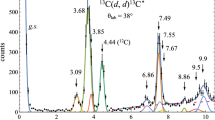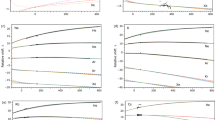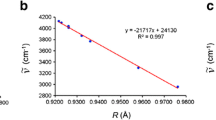Abstract
An unrestricted Hartree-Fock SCFMO method, based on the MCZDO method of Brown and Roby, suitable for computing spin densities in transition-element compounds, is described. The method is used to study spin densities on fluorine in Cs2MnF6, K2NaCrF6, K2MnF6, K2NaFeF6, KMnF3, RbMnF3 and KNiF3 using a “cluster” approximation in which a MF n−6 unit is explicitly considered. Excellent agreement is obtained between calculated and experimental spin parameters. The effect of the lattice is incorporated by using the electrostatic approximation of Brown, O'Dwyer and Roby. The lattice potential for these highly symmetric systems is found to have little effect on spin densities and charge distributions, but it effects substantial stabilization of the anion molecular orbitals. A general feature of the results is that central-atom 4p orbitals are scarcely involved in bonding, this being confined to the 3d and to some extent the 4s orbitals. Comments are offered on the lack of spin symmetry in the unrestricted Hartree-Fock wavefunctions of these systems, and the need to evaluate the core hamiltonian as accurately as possible.
Zusammenfassung
Es wird eine UHF-Methode, die sich auf das Verfahren von Brown und Roby stützt, zur Berechnung von Spindichten in Verbindungen der Übergangselemente beschrieben und auf folgende Systeme angewendet: Cs2MnF6, K2NaCrF6, K2MnF6, K2NaFeF6, KMnF3, RbMnF3 und KNiF3 mit MF n−6 als Baustein. Die Übereinstimmung mit den experimentellen Spinparametern ist ausgezeichnet. Die elektrostatischen Gittereinflüsse werden mittels einer Näherung von Brown, O'Dwyer und Roby berücksichtigt. Sie haben allerdings nur geringe Änderungen der Spindichte und Ladungsverteilung zur Folge, bewirken aber eine wesentliche Stabilisierung der MOs der Anionen. In allen Fällen gehen die 4p-Orbitale kaum in die Bindung ein. Der Mangel an Symmetrie der UHF-Funktionen dieser Systeme wird diskutiert und auf die Notwendigkeit eines guten Rumpfpotentials hingewiesen.
Résumé
Description d'une méthode SCF MO sans restrictions de spin, basée sur la méthode MCZDO de Brown et Roby, et appropriée au calcul des densités de spin dans les composés des éléments de transition. La méthode est utilisée pour étudier les densités de spin sur le fluor dans Cs2MnF6, K2NaCrF6, K2MnF6, K2NaFeF6, KMnF3, RbMnF3, et KNiF3; on utilise une approximation «d'essaim» dans laquelle une unité MF n−6 est explicitement considérée. Un très bon accord est obtenu entre les paramètres de spin calculés et expérimentaux. L'effet du réseau est introduit en employant l'approximation électrostatique de Brown, O'Dwyer et Roby. Le potential du réseau de ces systèmes hautement symétriques a peu d'influence sur les densités de spin et les distributions de charge, mais il provoque une nette stabilisation des orbitales moléculaires de l'anion. Un trait général des résultats est la faible importance dans le liaison des orbitales 4p de l'atome central, les orbitales 3d et 4s jouant le rôle essentiel. L'absence de symétrie de spin dans les fonctions d'onde HF sans restrictions pour ces systèmes, et la nécessité d'évaluer l'hamiltonien de coeur aussi précisément que possible sont l'objet de commentaires.
Similar content being viewed by others
References
Tinkham, M.: Proc. Roy. Soc. (London) A 236, 535 (1956); A 236, 549 (1956).
Hall, T. P. P., Hayes, W., Stevenson, R. W. H., Wilkens, J.: J. chem. Physics 38, 1977 (1963).
Marshall, W., Stuart, R.: Physic. Rev. 123, 2048 (1961).
Roothaan, C. C. J.: Rev. mod. Physics 23, 69 (1951).
Dahl, J. P., Ballhausen, C. J.: Advances quant. Chem. 4, 170 (1968).
Pople, J. A., Beveridge, D. L., Dobosh, P. A.: J. chem. Physics 48, 2026 (1967).
Brown, R. D., Roby, K. R.: Theoret. chim. Acta (Berl.) 16, 175 (1970); 16, 194 (1970); 16, 278 (1970).
Pople, J. A., Santry, D. P., Segal, G. A.: J. chem. Physics 43, 5129 (1965).
Klimenko, N. M., Dyatkina, M. E.: J. struct. Chem. 6, 604 (1965); 6, 714 (1965).
Löwdin, P. O.: J. chem. Physics 18, 365 (1950).
Goeppert-Mayer, M., Sklar, A. L.: J. chem. Physics 6, 645 (1938).
Moore, C. B.: Atomic energy levels, Vols. 1, 2, National Bureau of Standards 1950.
Brown, R. D., O'Dwyer, M. F., Roby, K. R.: Theoret. chim. Acta (Berl.) 11, 1 (1968).
Babel, D.: Structure and Bonding 3, 1 (1968).
Brown, D. A., Fitzpatrick, N. J.: J. chem. Soc. (London) A 1966, 941.
Burns, G.: J. chem. Physics 41, 1521 (1964).
Brown, R. D., James, B. H., O'Dwyer, M. F.: Theoret. chim. Acta (Berl.), in press.
Freeman, A. J., Watson, R. E.: Treatise on magnetism, Vol. IIA, ed. by Suhl, Rado. New York: Academic Press Inc. 1965.
Mulliken, R. S.: J. chem. Physics 23, 1833 (1955).
Rimmer, D. E.: Proc. Int. Conf. Magnetism, Nottingham, London: Inst. Physics and Phys. Soc. 1964.
Hubbard, J., Marshall, W.: Proc. physic. Soc. 86, 561 (1965).
Helmholz, L.: J. chem. Physics 31, 172 (1959).
—, Guzzo, A. V.: J. chem. Physics 33, 302 (1960).
Owen, J., Thornley, J. H. M.: Rep. Progr. Physics 29, 675 (1966).
Helmholz, L., Guzzo, A. V., Sanders, R. N.: J. chem. Physics 35, 1349 (1961).
Froese-Fischer, C: Canad. J. Physics 46, 2336 (1968).
Amos, T., Snyder, L. C.: J. chem. Physics 41, 1773 (1964).
Sando, K. M., Harriman, J. E.: J. chem. Physics 47, 180 (1967); 48, 5138 (1968).
Nakatsuji, H., Kato, H., Yonesawa, T.: J. chem. Physics 51, 5175 (1969).
Author information
Authors and Affiliations
Rights and permissions
About this article
Cite this article
Brown, R.D., Burton, P.G. Transition-element hexafluoride systems in ionic lattices. A Suhf molecular orbital study. Theoret. Chim. Acta 18, 309–328 (1970). https://doi.org/10.1007/BF00526451
Received:
Issue Date:
DOI: https://doi.org/10.1007/BF00526451




